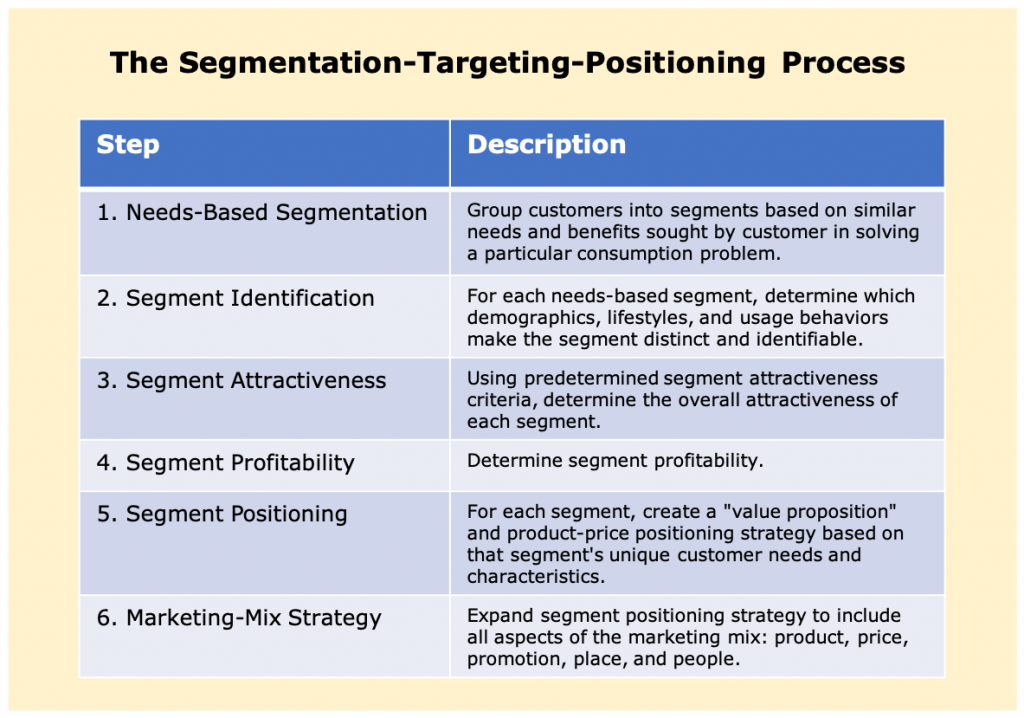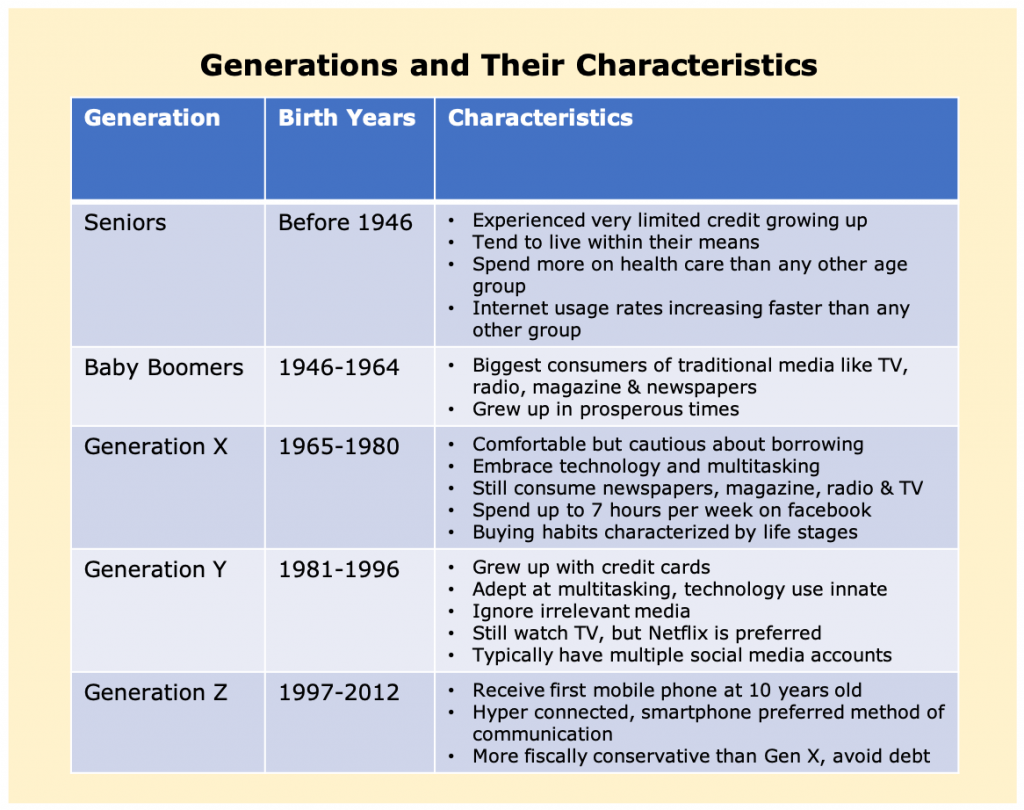Chapter 5 – Market Segmenting, Targeting, and Positioning
5.2 How Markets Are Segmented
LEARNING OBJECTIVES
- Understand and outline the ways in which markets are segmented.
- Explain why marketers use some segmentation bases versus others.
Sellers can choose to pursue consumer markets, business-to-business (B2B) markets, or both. Consequently, one obvious way to begin the segmentation process is to segment markets into these two types of groups.
Different factors influence consumers to buy certain things. Many of the same factors can also be used to segment customers. A firm will often use multiple segmentation bases, or criteria to classify buyers, to get a fuller picture of its customers and create real value for them. Each variable adds a layer of information. Think of it as being similar to the way in which your professor builds up information on a PowerPoint slide to the point at which you are able to understand the material being presented.
There are all kinds of characteristics you can use to slice and dice a market. “Big-and-tall” stores cater to the segment of population that’s larger sized. What about people with wide or narrow feet, or people with medical conditions, or certain hobbies? Next, we look primarily at the ways in which consumer markets can be segmented. Later in the chapter, we’ll look at the ways in which B2B markets can be segmented.
Figure 5.1 “The Segmentation-Targeting-Positioning Process” illustrates the various steps that a marketer will go through to identify, target and develop their positioning for each market segment they will go after.
The process of segmentation begins by understanding customers’ needs first. Looking at a product’s market, the process of segmentation attempts to examine the differentiating factors for customers within that market to determine which customers have similar needs, and subsequently group them together into a market segment. A product’s market could have more than one market segment, with each segment having different needs for the product. For example, consider the printer market. There are many different kinds of printers that meet the needs of various customers who belong to different market segments. Think about your own needs for a printer. You may be looking for a basic black and white toner printer that is sufficient for printing out various reports or papers you may have to write during your post-secondary career. A photographer or graphic designer, on the other hand, may have different needs than yourself. They may be looking for a printer that prints full colour photo quality pictures. A post-secondary student may have very different needs than a photographer or a graphic designer. Therefore, printer companies, may treat these two types of customers as two different market segments and will develop a marketing mix (product, price, place and promotion) that would position different printers to these two different market segments. ‡

Anthony Francescucci, Ryerson University CC BY-NC 4.0
Segmentation Identification
Once each of the segments’ needs are identified, we overlay additional characteristics that help to describe or understand various aspects of the customers within that particular segment. The segment identification process looks at various categories of characteristics that help to describe the customers within a particular market segment that have the same needs. This category of characteristics can include geographic, demographic, psychographic and behavioural characteristics.
Table 5.1 “Common Ways of Identifying Segment Buyers” shows some of the different types of buyer characteristics used to identify segment markets. Notice that the characteristics fall into one of four categories: behavioural, demographic, geographic, or psychographic.

This image is from Principles of Marketing by University of Minnesota and is licensed under a Creative Commons Attribution-NonCommercial-ShareAlike 4.0 International License.
By Behaviour
Behavioural characteristics identifies people and organization into groups according to how they behave with or act toward products.
Another way in which businesses identify segment buyers is by their usage rates—that is, how often, if ever, they use certain products. Companies are interested in frequent users because they want to reach other people like them. They are also keenly interested in nonusers and how they can be persuaded to use products. By identifying the reasons behind why these consumers do not use the particular product, companies try to create a version of the product that can overcome these reasons and turn nonusers into users.
By Demographics
Identifying a segment of buyers by personal characteristics such as age, income, ethnicity and nationality, education, occupation, religion, social class, and family size is quite common. Demographics are commonly utilized to identify segment markets because demographic information is publicly available in databases around the world. You can obtain a great deal of demographic information on the Statistics Canada Web site.
While demographics cannot capture everyone’s needs in all its details, it is often a good way to start understanding a target segment. For example, think about yourself in terms of your age, and what they may mean for your current product choices. At this point in your life, you are probably more likely to buy a small to medium sized car than a large family sedan. Marketing professionals know this. That’s why they try to segment consumers by their ages. You’re probably familiar with some of the age groups (see Table 5.2 “Generations and Their Characteristics”). Which category do you fall into?

Anthony Francescucci, Ryerson University CC BY-NC 4.0
By Geography
Geographic identification divides the market into areas based on location, and explains why the checkout clerks at stores sometimes ask for your postal code. It’s also why businesses put codes on print or e-coupons that correspond to a city or postal code. When the coupons are redeemed, the store can find out where its customers are located. City size and population density (the number of people per square mile) are also used for identification purposes. Have you ever noticed that in rural towns, McDonald’s restaurants are hard to find, but Dairy Queens (DQ) are usually easy to locate? McDonald’s generally won’t put a store in a town of fewer than five thousand people. However, this is prime turf for the “DQ”— because it doesn’t have to compete with bigger franchises like McDonald’s.
Proximity marketing is an interesting new technology firms are using to segment and target buyers geographically within a few hundred feet of their businesses using wireless technology. In some areas, you can switch your mobile phone to a “discoverable mode” while you’re shopping and, if you want, get ads and deals from stores as you pass by them, which is often less expensive than hiring people to hand you a flier as you walk by (source) .
In addition to figuring out where to locate stores and advertise to customers in that area, geographic identification helps firms tailor their products. Chances are you won’t be able to find the same heavy winter coat you see at a Walmart in Montreal at a Walmart in Victoria because of the climate differences between the two places. Market researchers also look at migration patterns to evaluate opportunities. Ethnically diverse restaurants are more commonly found in the major metropolitan cities in Canada. However, as major cities become over populated and immigrants move to smaller cities or the suburbs of larger cities, we are now seeing more ethnically diverse restaurants even in small cities.
By Psychographics
If your offering fulfills the needs of a specific demographic group, then understanding people’s demographic variables can be an important basis for identifying groups of consumers interested in your product. But what if your product crosses several market segments? For example, the group of potential consumers for cereal could be “almost” everyone, although different groups of people may have different needs with regard to their cereal. Some consumers might be interested in the fiber, some consumers (especially children) may be interested in the prize that comes in the box, other consumers may be interested in the added vitamins, and still other consumers may be interested in different types of grains. Associating these specific needs with consumers in a particular demographic group could be difficult. Marketing professionals want to know why consumers behave the way they do, what is of high priority to them, or how they rank the importance of specific buying criteria. Think about some of your friends who seem a lot like you. Have you ever gone to their homes and been shocked by their lifestyles and how vastly different they are from yours? Why are their families so much different from yours?
Psychographic identification can help fill in some of the blanks. Psychographic information is frequently gathered via extensive surveys that ask people about their activities, interests, opinion, attitudes, values, and lifestyles.
The identification techniques we’ve discussed so far in this section require gathering quantitative information and data. Quantitative information can be improved with qualitative information you gather by talking to your customers and getting to know them. Consumer insight is what results when you use both types of information. You want to be able to answer the following questions:
- Am I looking at the consumers the way they see themselves?
- Am I looking at life from their point of view?
Identification in B2B Markets
Much like consumer market segmentation, business market segmentation is very important because it helps companies to separate its business customers into groups with common business needs.
Many of the same bases used to identify consumer markets are also used to identify B2B markets. B2B sellers often identify their customers by geographic areas and tailor their products to them accordingly. Identifying behaviors is common as well. B2B sellers frequently divide their customers based on their product usage rates. Customers that order many goods and services from a seller often receive special deals and are served by salespeople who call on them in person. In contrast, smaller customers are more likely to have to rely on a firm’s website, customer service people, and salespeople who call on them by telephone.
B2B sellers, like B2C sellers, are exploring new ways to reach their target markets. Trade shows and direct mail campaigns are two traditional ways of reaching B2B markets. Now, however, firms are finding they can target their B2B customers more cost-effectively via e-mail campaigns, search-engine marketing, and “fan pages” on social networking sites like Facebook. Companies are also creating blogs with cutting-edge content about new products and business trends of interest to their customers. For a fraction of the cost of attending a trade show to exhibit their products, B2B sellers are holding Webcasts and conducting online product demonstrations for potential customers.

